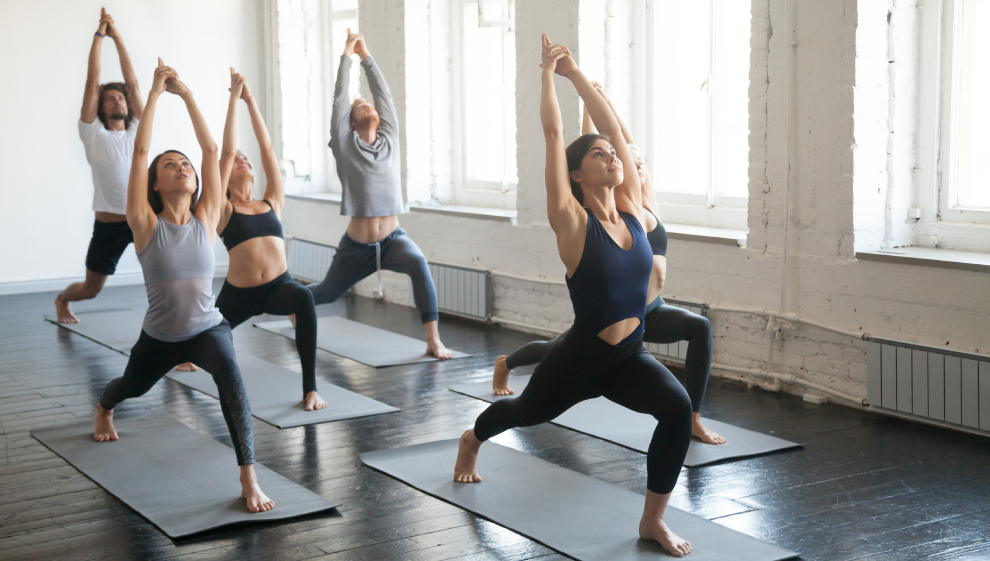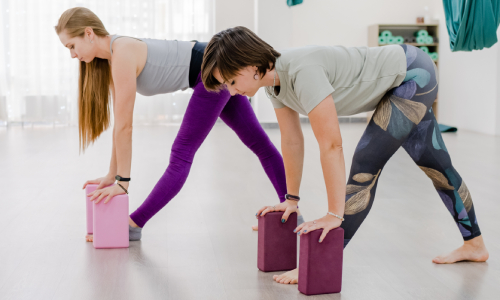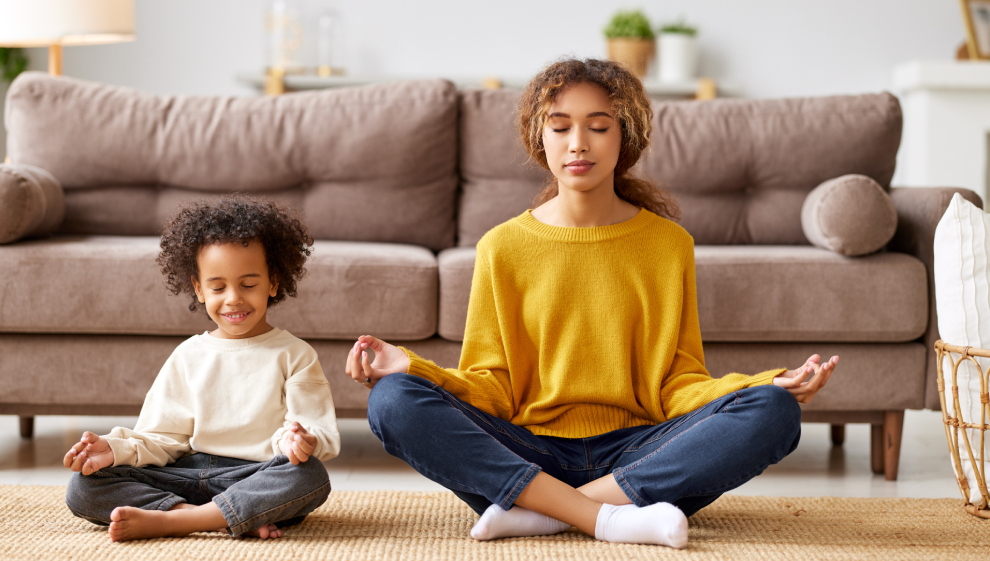How to get started with yoga: a beginner's guide
What is yoga?
Yoga is a physical, mental and spiritual practice that began in India. It was first written down more than 2000 years ago in the ‘Yoga Sutras of Patanjali’, but was likely passed down from teacher to student long before this ancient text.
‘Yoga’ comes from the Sanskrit root word ‘yuj’ meaning ‘to unite’, and the practice of yoga is often considered the union of body, mind and soul.
Over the years, many different interpretations and styles of yoga have evolved. Most agree it’s a way of living in the present and letting go of the ego and mental chatter, to ultimately be free from suffering.
The health benefits of yoga
A regular yoga practice can benefit both your physical and mental wellbeing. Here are some of the health benefits:
- Increases flexibility and balance
- Builds strength
- Improves sleep
- Helps keep your heart healthy
- Strengthens bones and eases joint pain
- Eases stress, anxiety and depression
- Improves concentration and mood.
Read more about the health benefits of yoga.
Yoga basics
The eight limbs of yoga

As yoga has been adapted for the West, the philosophy of yoga has been diluted somewhat. It’s often seen purely as a form of exercise – but movement is only one part of the discipline.
According to Patanjali, there are eight limbs of yoga, all of equal importance. Traditionally, you begin with the ‘yamas’ and progress through each one on the path to ‘samadhi’:
- Yamas: Five ethical and moral observances to live by (non-violence, truthfulness, non-stealing, moderation and non-greed)
- Niyamas: Five self-observations (cleanliness, contentment, discipline, self-study and surrendering to a higher power)
- Asana: Physical postures – originally this meant one posture to be comfortable in for an extended time, but now includes all physical yoga poses
- Pranayama: Breathing exercises
- Pratyahara: Withdrawal of the senses
- Dharana: Concentration
- Dhyana: Meditation
- Samadhi: Enlightenment.
Today, people often start with a yoga class that includes mainly asana, with a bit of pranayama and dhyana.
But it’s useful to know that if you’re injured or not able to move your body for whatever reason, you can still practice yoga through breathing exercises or meditation.
Styles of yoga

There are many different styles of yoga, some more advanced than others.
As a beginner, it’s a good idea to start with a hatha, vinyasa, restorative or yin yoga class and see which one works best for you:
- Hatha yoga: This traditionally encompassed all forms of physical yoga, but now it’s often used to refer to a gentle, slower form of asana with more static poses.
- Vinyasa yoga: This style evolved from Ashtanga yoga in the 80s. Every movement in a vinyasa class is coordinated with the breath, and you flow from pose to pose.
- Yin yoga: This is a slower-paced style of yoga where you perform a series of seated postures that are held for a few minutes at a time. The aim is to find your edge in each pose, then find stillness and let the time pass by.
- Restorative yoga: Another chilled-out one, restorative yoga is ideal for winding down after a long day. The focus is on relaxation, so it’s often a slow flow with easier poses, and a range of props such as bolsters, blankets and eye pillows.
Here are some more challenging styles of yoga, when you’re ready to give them a go:
- Ashtanga yoga: This is a vigorous series of about 75 postures that takes an hour and half to two hours to complete. K Pattabhi Jois developed Ashtanga in India in 1948, before popularising it in America in the 70s.
- Iyengar yoga: Founded by BKS Iyengar, who had the same teacher as K Pattabhi Jois, the emphasis of Iyengar yoga is on alignment and precise movements using props.
- Bikram/hot yoga: Bikram Choudhury created Bikram yoga in the early 70s – it’s a sequence of 26 poses in a room set to a steamy 40°C. Hot yoga, can be any style of yoga in a heated room, at a more manageable 33°C.
- Rocket/power yoga: Rocket yoga was created by Larry Schultz as a way to make Ashtanga more accessible – it may still be fast-paced but the sequence is less rigid. Similarly dynamic is power yoga, which is even more flexible in its content.
Getting started with yoga
Yoga clothing and equipment
The great thing about yoga is you can do it almost anywhere, with no need for lots of fancy gear or props.
In terms of clothing, anything that’s comfortable and allows you to move is ideal. Obviously, dress for the temperature too, so bring along socks and extra layers in cooler weather, or even just for savasana at the end when your body temperature can drop.
People tend to practice asana on a yoga mat as it provides some cushioning for the hands and knees, as well as added grip for poses like downward dog.
We provide a range of props in our gyms, such as straps, blocks and bricks to help make the poses more comfortable and accessible.

If you’re practicing at home and don’t have any yoga props, here are some easy swaps:
- Yoga brick/block: These are used to raise the ground up to you in poses like triangle and side angle, but a thick hardback book is just as effective
- Yoga strap: If you can’t reach your toes in certain poses, hook a belt or dressing gown strap around your foot and hold onto it instead to avoid straining for a bind
- Bolster: This is often used under the knees in savasana to ease tension in the lower back, but you can get the same support with a pillow, cushion or rolled up blanket or towel
- Knee mat: If you need support in kneeling poses, fold a section of the yoga mat over itself to create a triple layer, or use a blanket or towel for extra padding.
Tips for your first class
Do:
- Get to class early: This allows you to take a few minutes to settle in to the space and let go of your day so far. It also gives you some buffer time if your journey is delayed, so you don't disturb the beginning of the class.
- Enter the class with an open mind: Forget what you think you know about yoga and listen to the teacher’s instructions.
- Follow the teacher’s cues up to a point: They’re there to guide you, but make sure you always find what feels right for you and your body on that particular day. If you need to take a child’s pose at any point, that’s totally fine. You do you.
- Take the easier option if you need to: Teachers should offer a few options for different levels, so take the one that works for you.
- Make use of props: As mentioned, props like blocks and straps can help make certain poses more accessible.
- Focus on your breath: This is a given in the pranayama exercises, but also during the asana – if you’re finding a pose challenging, use your breath to invigorate yourself to carry on.
Don’t:
- Worry about what your asana looks like: If you find this happening, try closing your eyes to experience what it feels like instead.
- Compare yourself to others: Everyone will be at a different stage in their yoga journey, and all bodies are different – the way some people’s joints are structured means they will always be limited in certain movements.
- Strive to achieve the ‘perfect pose’: For example, a common mistake in forward fold is to grab hold of your toes when you don’t yet have enough flexibility in your spine. It’s better to hold your shins and keep your spine long, than strain to get your nose to your knees.
- Get disheartened if your mind wanders: Yoga isn’t about getting rid of these thoughts, it’s about accepting them and moving on. Again, use your breath or any bodily sensations to anchor you in the present moment.
How to fit yoga into your daily routine
As with any habit you want to keep, you have to carve out time for it. Committing to a weekly class is a good place to start.
We offer a range of yoga classes at our gyms, which tend to be around an hour long. Depending on whether you’re an early bird or a night owl, you could kickstart your day with a vinyasa yoga class, or wind down with a yin or restorative yoga class.

We also have a few free online yoga classes you can try. These are shorter at around 30 minutes long, so you could easily fit them into your lunch break if you work from home.
As mentioned, yoga isn’t just asana – here are our free online meditation classes, which include ‘morning boost’ and ‘evening meditation’.
Once you’ve learned a few breathing and meditation techniques, you can take these off the mat with you into your day, to keep reaping the benefits.
Here are some examples of when you can close down the eyes and take a few calming deep breaths, instead of reaching for your phone:
- As soon as you wake up
- Before bed
- While you’re on the train or bus
- While you’re waiting in a queue
- When you need a screen break if you work on a laptop most of the day
- During your lunch break
- When life gets too much, whether internally or externally, and you need to take a breather.
Try our beginner’s yoga routine
Now you know the basics, why not give this online yoga class a try? You’ll be in safe hands with Michaela who’s designed this 30-minute class for absolute beginners:
Want to learn more about yoga?
Read Ten yoga terms you should know.
Last updated Tuesday 5 September 2023
First published on Friday 18 August 2023

